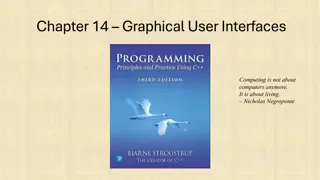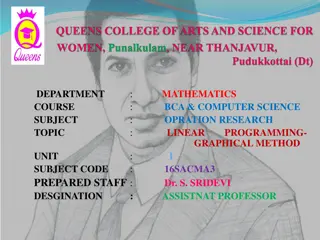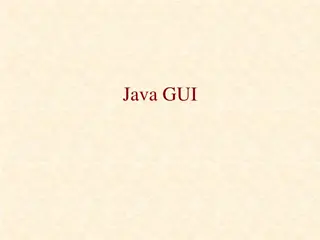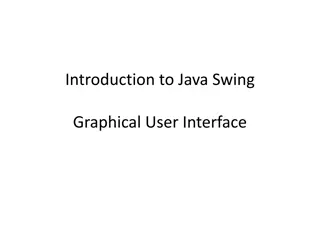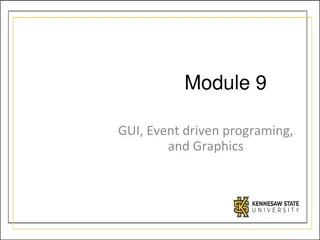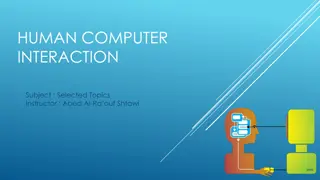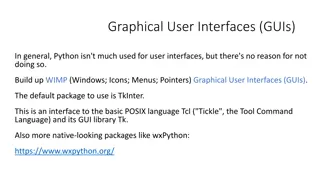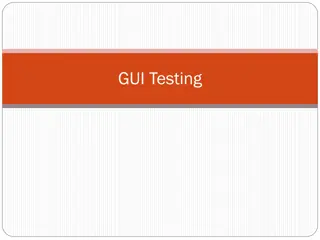Introduction to GUI in Graphical User Interface 2
This content delves into creating JFrame in Java, customizing frame windows, and using JOptionPane for dialog boxes in GUI applications. It covers essential components like setting title, size, visibility, and location of frames. Subclassing JFrame to create customized windows is also discussed. Furthermore, it explores accessing the content pane to place GUI objects such as buttons, labels, and scroll bars. Practical examples and step-by-step guidance are provided to enhance understanding of GUI development.
Download Presentation

Please find below an Image/Link to download the presentation.
The content on the website is provided AS IS for your information and personal use only. It may not be sold, licensed, or shared on other websites without obtaining consent from the author.If you encounter any issues during the download, it is possible that the publisher has removed the file from their server.
You are allowed to download the files provided on this website for personal or commercial use, subject to the condition that they are used lawfully. All files are the property of their respective owners.
The content on the website is provided AS IS for your information and personal use only. It may not be sold, licensed, or shared on other websites without obtaining consent from the author.
E N D
Presentation Transcript
Introduction to GUI in Graphical User Interface 2 Nouf Almunyif 1
Creating a JFrame a JFrame class have the following component: JFrame(); JFrame(string Title); setTitle(String title ); setSize(int Wedth , int length); setVisible(boolean var); setLocation (FRAME_X_ORIGIN, FRAME_Y_ORIGIN) Nouf Almunyif 2
Creating a JFrame a JFrame class have the following component: setResizable(boolean var); setDefaultCloseOperation(JFrame. ????????); EXIT_ON_CLOSE DO_NOTHING_ON_CLOSE Nouf Almunyif 3
showMessageeDialog General syntax JOptionPane.showMessageDialog(ParentComponent, message string, box title , msseg type); Example: JOptionPane.showMessageDialog(null,"Hello","Title", JOptionPane.INFORMATION_MESSAGE); Example: JOptionPane.showMessageDialog(null,"Hello"); Nouf Almunyif 4
Example Nouf Almunyif 5
Example After Pressing OK or closing the How are you? dialog, the Good Bye dialog appears Nouf Almunyif 6
Subclassing JFrame To create a customized frame window, we define a subclass of the JFrame class. class TESTGUI extends JFrame { Public TESTGUI () // constructor {// necessary code //set the frame default properties} } WRITE A CODE TO DO THE FOLLOWING : An instance of TESTGUIwill have the following default characteristics: The title is set to My First Subclass. The program terminates when the close box is clicked. The size of the frame is 300 pixels wide by 200 pixels high. The frame is positioned at screen coordinate (150, 250). Nouf Almunyif 7
This gray area is the content pane of this frame. The content pane is where we put GUI objects such as buttons, labels, scroll bars, and others. We access the content pane by calling the frame s getContentPane method in class Container. Nouf Almunyif 9
Frames content pane The Class Container is contained in the package Java.awt. import java.awt.*; //IN CONSTRUCTOR Container contentPane = getContentPane(); contentPane methods: setBackground(Color.BLUE); add(Object_name); setLayout( layout_type); Nouf Almunyif 10
Placing GUI Objects on a Frame There are two ways to put GUI objects on the content pane of a frame: Use a layout manager (using setLayout()method) FlowLayout BorderLayout GridLayout Use absolute positioning null layout manager Nouf Almunyif 11
Buttons Example of Using FlowLayout to places button on the frame (in the top-to-bottom, left-to right order) Methods : addActioLesitener(actioLesitener obj); Nouf Almunyif 12
Text Field A JTextField object allows the user to enter a single line of text. JTextField(int columns ); JTextField(); setColumns(int col); getText(); //return the text contained in text field setEditable(boolen var); // if the value of var is false the user can t type in the text field addActioLesitener(actioLesitener obj); // register a listener object to the text field Nouf Almunyif 13
JTextArea JTextArea textArea = new JTextArea( ); . . . textArea.setText("Hello\n"); textArea.append("the lost "); textArea.append("world"); textArea.setColumns(int col); textArea.setRows(int row); textArea. setEditable(boolen var); Nouf Almunyif 14
JTextArea By default a JTextArea does not have any scroll bars. To add scroll bars, we place a JTextArea in a JScrollPane object Nouf Almunyif 15
Lable A JLabel object displays uneditable text (or image). JLabel imgLabel = new JLabel(new ImageIcon("cat.gif")); Nouf Almunyif 16
Example: adding two numbers program Nouf Almunyif 17
Example: adding two numbers program FlowLayout() GridLayout(3,2) Nouf Almunyif 19
event handling We have learned how to create a window ,container ,label, buttons and text fields Now we should specify In button how such a button behave when we click it? In text field An action event is generated when the user presses the ENTER key. Nouf Almunyif 20
event handling clicking a button create an event known as action event, which sends a message to another object known as action listener , when he receives the message he perform soma actions( execute a method). The mechanism to process events is called event handling. Nouf Almunyif 21
event handling you must do two things : 1. You must define the method that will be invoked when the event is sent to the listener 2. for each object (button or text field )you must specify the corresponding listener object (this known as registration). Nouf Almunyif 22
action event The action event is handled by the class ActionListener witch contain only one codless method actionPerformed. The class ActionListener is a spiceal ype of a class called interface Public interface ActionListener{ Public void actionPerformed(ActionEvent e ); } Nouf Almunyif 23
action event We can t instantiate an object from interface so we build a class on top of it Private class Buttonhandler implement ActionListener { Public void actionPerformed(ActionEvent e ){ // write what should button do } } Nouf Almunyif 24
2. specify the corresponding listener object Nouf Almunyif 25
Example: adding two numbers program cont. Nouf Almunyif 26
Container as Event Listener Instead of defining a separate event listener such as ButtonHandler, it is much more common to have an object that contains the event sources be a listener. Example: We make the frame a listener of the action events of the buttons it contains. Nouf Almunyif 31
The changes to the previous program are Remove class Bhandler and all its objects and just keep the actionPerformed method Nouf Almunyif 32
JTextField events If we want to respond to both button clicking and pressing ENTER event in TextField 1- We should register a listener to both of them Nouf Almunyif 33
public void actionPerformed(ActionEvent event) { if (event.getSource() instanceof JButton) { //button code } else { //TextFiled code } } Nouf Almunyif 34
What if there is two buttons? public void actionPerformed(ActionEvent event) { JButton clickedButton = (JButton) event.getSource(); if (clickedButton == button1) {} Else {} Nouf Almunyif 35


